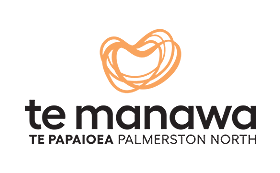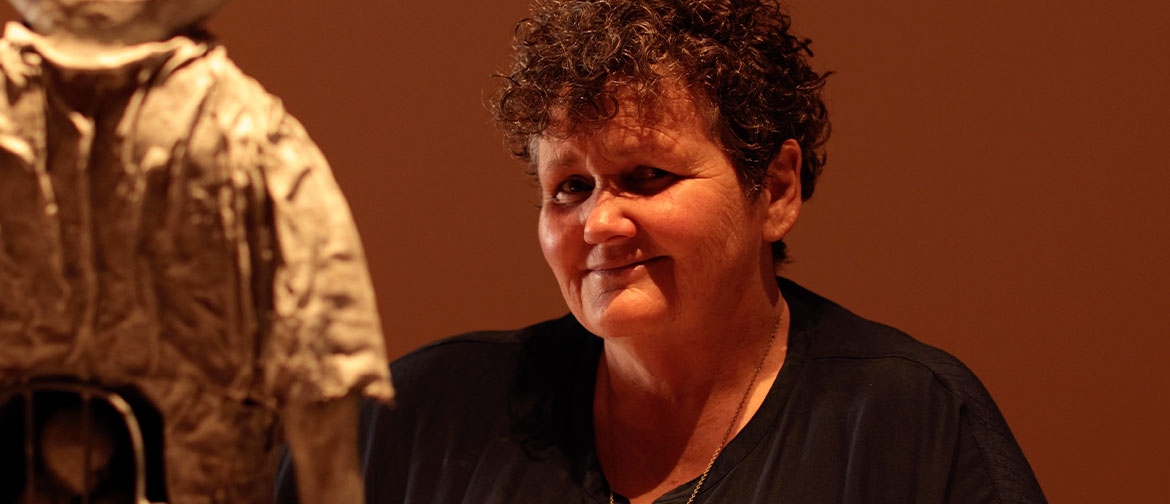Catherine: I started out doing copper sculptures. I did that for about 20 years, then realised that it was just keeping me sick. That’s when I decided to sit down and experiment with other media and other materials. I started the Secret-Keeper project; that’s been going for about 9 years. There are more than 70 sculptures and I’ve written a book.
Te Manawa: And this is the latest installation?
Catherine: It started out with just one little girl on a suitcase with a teddy bear, and I took it to my psychiatrist and psychologist, and they said, “what is that,” and I said, “it’s what I can’t tell you verbally”. They asked whether I could make any more. So I went home and after seven or eight years I’ve got 70 sculptures, ranging from the size of a three year old down to quite tiny. It’s to portray what I couldn’t say verbally about my childhood sexual abuse and trauma.
Karen: There’s a book too. Each of the sculptures has its own metaphor. When the exhibition was up as a whole, I know people’s responses to it were massive. It’s just a little selection in here, isn’t it?
Catherine: Yes. We’ve had a really big response; about 2000 people going through each exhibition. I spent 13 days at the Royal Commission of Inquiry that’s going on at the moment for abuse in state care, and it’s the first time in New Zealand that the Royal Commission has allowed an art exhibition as someone’s personal statement. That opens up a lot of doors for artists to explain stuff in a way that’s visual rather than words. What you could say in 10,000 words you can say in one sculpture, and it’s just so much more poignant having that 3D object in front of you.
Karen: I think it’s important too that when you experience trauma, the part of your brain that processes language shuts down. That’s why it’s so hard for so many of us to say what’s happened, because how do you explain it? There’s so much stigma and shame and people’s stereotypes and myths around what that means, if you tell them that sort of thing. Having a voice through art is huge.
Catherine: A lot of people respond to it because those who have had trauma in their life respond to it because it’s them that they can see in each image. We get people saying, “how did you know my story, how did you know my words, that’s what I would have said,” and things like that. But it also gains empathy from people who haven’t been sexually abused or haven’t had domestic violence in their life, because they don’t understand it fully.
I had a lady come to me and bought a book, in Auckland at the inquiry, and she said, “my sister has never understood”. She emailed me about three weeks later and said, “thank you for what you are doing,”. She sent her sister a book, and her sister said, “now I can understand what you could never tell me; I could never see it.” Their relationship’s been repaired, just from that book. We’re getting 80-year-old women coming to the exhibition and saying, “I can relate to this, this happened to me,” and it’s the first time they’ve ever spoken of it. That’s a long time to keep a secret.
Karen: It happens every year with the WAI exhibition, wherever it is. I think what we do here and what Catherine does with the Secret-Keeper exhibitions is that it opens a space that is safe for people to say “oh, someone else is talking about this and it’s safe for me then to say ‘it happened to me’”, and there won’t be a negative social response to it. That’s the stuff that’s difficult about violence, because there are expectations around who you are, that you’re going to be non-functional.
Catherine: There’s a lot of stigma around it.
Karen: and shame, embarrassment, and not knowing how to respond to you if you say that.
Catherine: Shame is a big thing. People are too afraid to speak out because they feel ashamed, and as if they’re the only person it’s ever happened to. Whereas when they see a painting or a sculpture or a drawing, or anything visual, they can relate to it because it’s something right in front of them, a physical object that they can see, that explains what they’ve been through so they don’t feel alone. They feel safe to be able to say “it happened to me as well”.
Karen: The thing that Catherine brings really well into the space is she’s got that conceptual understanding and has the courage to say it, but is also an exceptional maker and shares her talents with everyone in the collective. A big part of WAI is us all sharing and learning from each other.
Catherine: It’s a really supportive environment, so you may know how to do something but are struggling in another area, so someone can always step up and help you with it.
Te Manawa: With such a large body of work, how do you approach making the next one?
Catherine: It just happens. It’s a growth thing. As I grow on the journey, the sculptures are growing as well. I started out with The Secret-Keeper, and I’ve got another series I’m working on at the moment called The Invisible Children: Seen but Not Heard. That’s the work you see there. It’s partial images of people made from one strand of wire woven together to make a whole. I’m working on a huia series as well. As your journey evolves, your sculptures evolve as well. You grow with your art. We’re looking at taking it overseas as a next step.
Te Manawa: How long does each piece take?
Catherine: Quite a long time. It’s taken eight or nine years to make the 70 sculptures but like I said you have to grow with the sculptures. Sometimes I’m asked whether the book came first or the sculptures, but they work in unison. Sometimes I could sculpt but not write, and other times write but not sculpt, so your brain and your journey has to slowly keep up with you. Sometimes I could sculpt all day, but other days I couldn’t, but I could write metaphors, so it was a journey of whatever part of the brain you felt in at that time. Some of them take weeks or months; others are smaller and quicker.
Karen: Often it’s not specific experiences that we want to talk to with our making, it’s more who we are as a person and those things that have allowed us to still be here: our strength, our dignity, our resistance, our courage. All of that comes through, as well as exploring the idea of “yes, that happened, but here’s who we are now.”
Catherine: A lot of people get quite insular and they withdraw from society – I did – and they’re too scared of the stigma to go out. It feels like wearing a neon sign that says “I’ve been sexually abused” or “I’ve been raped” or “I’ve experienced domestic violence” and you think everybody in society can see it. So you slowly withdraw from society more and more, and you become this tiny insular thing in your studio. It take a lot to go from being in your studio to out into the public eye, and that’s one of the biggest things. This exhibition that I’ve been doing, The Secret-Keeper, it was never going to be seen in the public eye. It was only something to do with my healing. My psychiatrist and psychologist kept saying, “this is going to help millions of people.” It took them four years of slowly working on me to bring those sculptures out into the public eye.
Now I’ve been speaking at conferences, and one of the big goals I want to do is try and speak at conferences around the world so that policymakers have a true understanding. They read thousands of pages of words, but one sculpture can change their whole attitude. If they really understand what it’s like to have domestic violence and sexual abuse in their life, hopefully they’ll make better policies around art as being a big part – because the first thing a lot of places cut is the art, yet art is what heals people on many different levels.
Whether it’s making a papier-mâché balloon with kids who’ve been traumatised through domestic violence, or sculpting 70 sculptures. It’s on so many different levels, but that sculpture and that artwork gets them back into society. Even if it’s enabling them to go down and get the groceries, or join a group that meets once a week like WAI. But it’s getting people involved back with the community that otherwise would be hidden in their own home. And that’s what art’s so important about doing.
Karen: Our philosophy at WAI is not that people come in and talk about their experiences. They come in and they make. And talking happens, we all talk about things, but that’s not the point of the group. We’re artists, we’re activists, we’re advocates for social change. That’s been the huge thing about WAI: it allows us to find our feet through our art-making. And like you say, everyone talks to us when we experience violence. They talk about us.
Catherine: Or over us.
Karen: Yes, or talk for us. But we don’t get to talk for ourselves, and this exhibition and this art-making allows us to have a voice in that space. We’re the experts in this space, why don’t we have a voice? People need to be listening.
Catherine: And we don’t need to speak because our art speaks for us. The conversations we have amongst each other are a community conversation, but you look at one piece of art, and that will say a thousand words
Karen: And it tailors itself to whoever’s looking at it. That’s the cool thing about it: whoever’s looking at your work will read their stuff from it, and that’s what makes it so powerful
Catherine: That’s what I did with The Secret-Keeper. For 20 years I’d been making copper sculptures that looked exactly like their subject. I could make a crayfish and it would look like a perfect crayfish, or a rose. But it was the first time I’d gone to sculpt emotions. So I didn’t want to put a lot into the pieces, I wanted them to be very basic. The more I put on the sculptures, the less people could represent themselves in them. They’ve got no hair, no facial features really, they’re very plain. I use only five colours in the whole series. Less is best, and then someone can come and put themselves in each piece. The more I fill in the gaps, the less they can put their own message into it. That’s the big response we’ve had, I think: they’re so basic but they tell so much.




